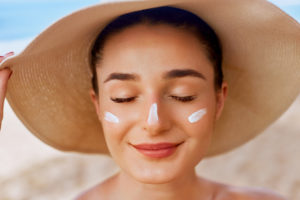
By Dermatology Consultants
 Protect Yourself from the Sun
Protect Yourself from the Sun
By your twenties, you should have established good habits for sun protection. As Benjamin Frankly once wisely said, “An ounce of prevention is worth a pound of cure.” Although he wasn’t referring to sunscreen (he was actually talking about fire safety), one ounce of sunscreen is actually the amount that’s recommended to coat your face and body completely! One ounce is equivalent to about a golf-ball-sized amount of cream.
Trust us, if you start a sun protection routine as early as possible you will thank yourself later. We constantly hear, “I wish I knew about sunscreen when I was younger,” or “If only I hadn’t used baby oil or tanning beds.” Sun protection is the best thing you can do for your skin to avoid not only brown spots and wrinkles, but skin cancer too. It’s our intent as dermatologists to help you enjoy the outdoors safely. To do this we recommend:
- Sunscreen
- Sun-protective clothing and hats
- Sun-protective behavior (avoid the peak mid-day sun, seek shade)
More tips:
- Choose broad-spectrum sunscreen (works against both UVA and UVB rays) with SPF 30 or greater and reapply every 2 hours while outdoors.
- Develop a habit of putting sunscreen on your face, ears, neck and any part of your chest that is exposed EVERY MORNING! Skin cancer can occur even in every crevice of the ear and behind the ear. Be thorough.
- Reapplication is vital, especially if you’re outside for a long time or swimming or sweating.
- Bear in mind that despite what many think, cares’ side windows do not protect enough against UVA rays.
Retinoids
Retinoids (which are prescription-strength) or retinols (which are over-the-counter) are topical treatments that are made from vitamin A. Retinoid/retinol creams or gels have several positive effects on skin, including improved skin thickness, smoothing fine lines and skin and lightening brown spots and other pigmentation problems. Prescription-strength retinoids historically has more evidence behind it in rigorous, peer-reviewed studies for improving skin, compared to any other topical treatment.
Prescription-strength retinoids may cause dryness or irritation for some people. In such cases, retinols are often tolerated better and now come in a number of elegant formulas. Pregnant women, however, should avoid all types of Vitamin A creams.
Neurotoxins
We are frequently asked at what age you should start neurotoxin (toxins) treatments. Toxins weaken the facial muscles to cause less movement. There several toxins on the market, but the first and most well-known is BotoxTM. Others include DysportTM, XeominTM and JeuveauTM.
To answer the question: the best time to start treatments with toxins is whenever you first notice fine lines when your skin is at rest (i.e. your face isn’t moving). Areas where fine lines usually develop first include the forehead and outside corners of the eye (crow’s feet). For most people this happens in late 20s or early 30s. If you’re very expressive or have been exposed a great deal to the sun, it can happen sooner. If toxins are used at the onset of fine lines further deepening and progression of the lines can be prevented. Currently, new techniques allow for a much more natural look after toxin treatment (instead of the old “frozen” appearance).